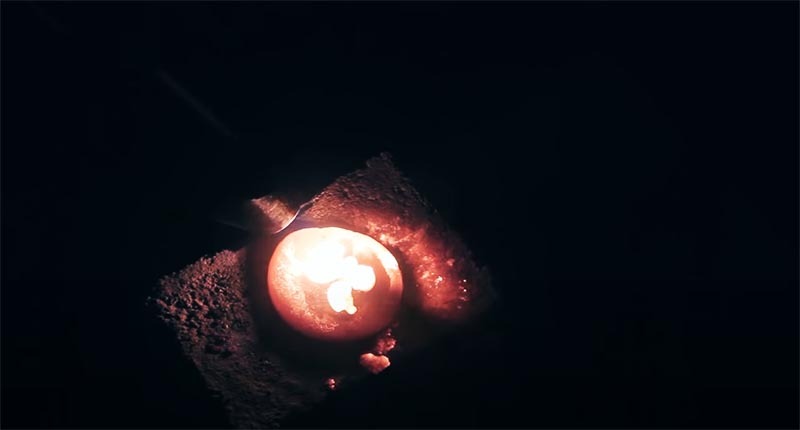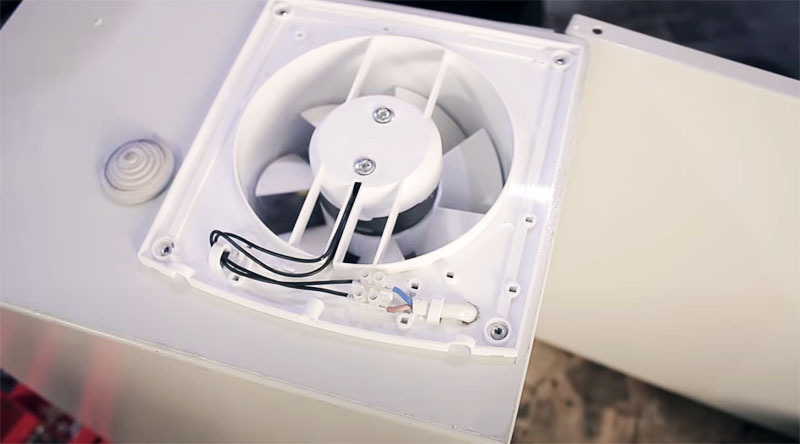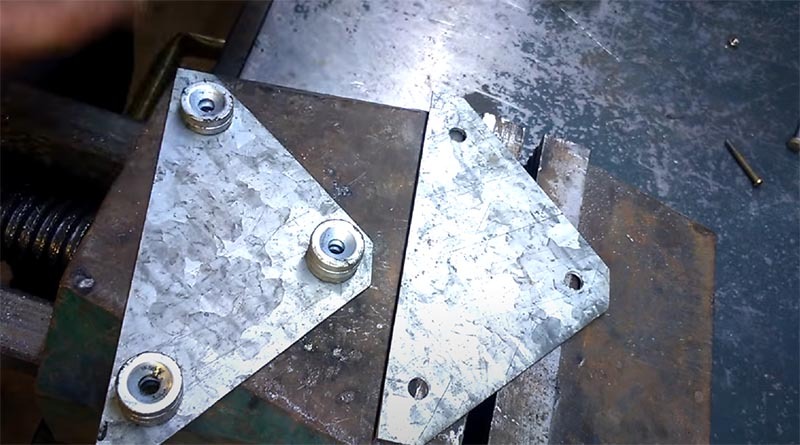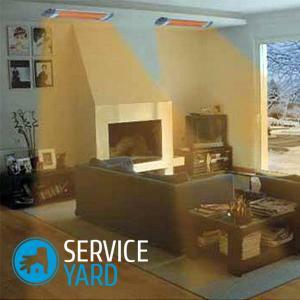
- How does an infrared heater work?
- Classification of infrared heaters
- Advantages:
- Cons
- Application
- How to choose an infrared heater?- The main criteria of
The use of long-wave instruments for creating an optimal indoor climate in a room is one of the most common ways of heating premises. However, the attitude towards infrared heaters, to put it mildly, is ambiguous. Some - do not really represent their advantages, others - they doubt their safety. We will develop these doubts and determine how to properly organize the heating of the room with the help of an infrared heater. To efficiently heat a room, it's not enough just to buy infrared heaters for your home. It is equally important to determine the location of the device and the mode of its use. All these nuances will be discussed in this article.
to the contents ↑How does an infrared heater work?
As the name implies, the principle of the infrared heater is to emit and spread infrared waves. If a certain body or substance is heated to the set temperature, then they become sources of electromagnetic radiation of the infrared range.
Important! The length of electromagnetic waves depends on the temperature of the surface. The higher it is, the shorter the wavelength.
to contents ↑Classification of infrared heaters
Heaters, depending on the range of radiated waves, are divided into the following groups:
- Shortwave radiation.
- Average wave radiation.
- Long-wave radiation.
Important! More than 90% of the radiation from infrared devices is used for heating the room itself, and only 8% for heating the air. This device differs from the usual fireplaces and stoves, for which the main coolant is air. This feature of heating infrared devices produces the most comfortable heating mode, which is best perceived by both people and animals.
Based on the temperature of the radiating surface, the heaters are divided into 3 groups:
- Low-temperature( 100 to 600 degrees).
- Medium temperature( from 600 to 1000 degrees).
- High-temperature( more than 1000 degrees).
Important! If heaters for home are needed, infrared, preferably low-temperature devices with long-wave radiation. Devices of medium- and high-temperature type for use in domestic purposes are not recommended.
to the contents ↑Advantages:
- Economical. Infrared heaters for home have higher heat dissipation than other heat sources. In addition, there is no need for labor-intensive room heating with solid fuel. Compared to an electric radiator, an infrared source consumes less electricity.
- Ease of use. They can be used all year round, without waiting for the start of the official heating season. The heater is mobile, it can be easily transferred from one room to another, transported from a city apartment to a holiday home.
- Comfort when used. Unlike convectors, infrared heaters do not dry air, do not burn oxygen, do not create vortex flows that raise dust. For this reason, the use of these devices is possible in families where there are allergic people and people suffering from bronchial asthma. In addition, people feel more comfortable in such a room.
- Ease of installation, the possibility of self-installation of the device. Some professional skills when installing heaters are not needed.
- Rational use of space. The wall and floor unit can be installed even in the closest room.
- Quiet operation.
- Safety against fire.
- Fast heating of the room( on average, this is enough for 20 minutes).
Important! There is no negative effect of magnetic waves on the body, moreover - the use of infrared magnetic radiation for health is proved:
- Electromagnetic waves of the infrared range contribute to the reduction of joint pain.
- Improves overall health, normalizes metabolic processes.
- Immunity is strengthened, the body's resistance to infectious diseases increases.
Cons
There are some infrared heaters for the house and certain drawbacks. As a rule, they are connected with the fact that the device is chosen incorrectly:
- If you have chosen a too powerful device, you risk getting burns. Negative consequences can be, if you have got poor-quality production from doubtful manufacturers. For this reason, you should give preference to the products of well-known brands.
- A small drawback is that the lamp is constantly on. The glow is present constantly, even at night. Some such "night light" is annoying. So think about whether you will install the device in the bedroom.
In all other respects the devices are irreproachable.
to content ↑Scope of application
As already mentioned, infrared heaters are excellent for heating permanent or temporary housing throughout the year. But in fact, the scope of use of the device is much broader.
Important! You can use a heater in a glassed-in cold loggia, in a greenhouse, a winter garden, rooms for pets. At the same time, there will be no prohibitive costs for electricity.
to the contents ↑How to choose an infrared heater?- Basic criteria for
Choosing heaters for home infrared, pay attention to 3 main factors:
- A variation of the heater.
- Power.
- Place and mode of use.
Variation:
- Long-wave radiators are equipped with a heating element. The heating temperature of the metal plate does not exceed 230 degrees. Such devices are the safest in terms of ignition. The minimum safe distance between the device and other items is 0.5 m.
- The heating element for the short-wave device is a spiral, which is placed in a tube of glass. The tube heats up strongly enough( up to 600 degrees).For this reason, home heaters are infrared of this type are much less safe than the longwave version. The minimum distance from the device to other objects is 3 meters, and for a dwelling it is rather inconvenient.
Important! For domestic use, a long-wavelength device is preferable.
Power
Specialists advise to choose a device for heating according to this principle:
- 0.1 kW of power per square meter of the area of the room;
- If you decide how to choose an infrared heater for a dacha, one 0.13 kW of power is taken per "square" of space.
Important! The power of the household heater does not exceed 1.5 kW.For this reason, to heat the room in 25-30 "squares" you will have to purchase 3 appliances of 1.0 kW and evenly distribute them around the perimeter.
If you select an inadequate power device, you will not be able to warm up the room, and the savings turn out to be doubtful. The faster the heater creates the desired microclimate, the sooner it turns off and does not consume extra energy. 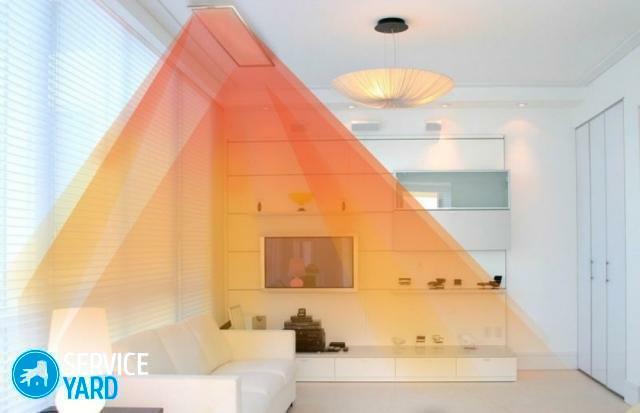
Ceiling, floor or wall-mounted version?
There are four types of execution of infrared heating devices:
- Floor.
- Wall mounted.
- Ceiling.
- Skirting boards.
First you need to find out how the heater will be used: as a stationary device or will move from one room to another.
Proceeding from this, we decide which heaters for home infrared will work best:
- The most convenient are the ceiling type heaters. They do not occupy much space, they have a wide range of radiation. Ceiling models can be built-in or fixed to brackets. In the latter case, the distance from the heater to the plane of the ceiling is about 50 mm.
- Wall heaters should be secured from the floor at a distance that is inaccessible to children and pets.
- If you plan to place the device under the window, the skirt heater is perfect for you.
- Mobile heaters are smaller in size and power.
Heaters for home infrared: types of heating elements
The type of heating element is determined by the material from which the sheath protecting the radiator is made. The shell can be metallic, ceramic or quartz.
Halogen heating element
This is a halogen lamp that gives infrared radiation. Inside the lamp is a thread made of carbon fiber or tungsten.
Important! The main disadvantage of this type of lamp is short-wave radiation, which can be harmful to health.
Carbon heater
Made in the form of a quartz tube. Inside the tube is a vacuum in which there is a spiral of carbon material. The advantage of the carbon element is rapid heating. In addition, the carbon cell has a higher efficiency than the metal plate.
However, there are also disadvantages:
- service life is about two years;
- power consumption of carbon is quite large: 1.2-2.5 kW.
- glow - red, can irritate the eyes.
Important! Carbon heating element is not recommended for people suffering from allergic reactions and bronchial asthma.
Ceramic heating element
It is well protected, therefore it does not shine during operation. The working life of the device is 3 years or more. Compared with the quartz element, ceramics are more expensive. The advantage of the ceramic element is also economical energy consumption( from 50 W to 2 kW).The disadvantage is slow warming up.
Miktermic element
Represents a tubular metal element. It differs with stable work, convenience and reliability of use.
Disadvantages:
- high cost;
- quiet crackle during operation.
Insulator type
The insulator is designed to prevent the case from heating to a temperature exceeding 95 degrees. The best is considered a basalt insulator. Ideal if it does not contain any impurities. It is not out of place to ask about the availability of a hygienic certificate. Important points when choosing an infrared heater for the house
- The highest efficiency in ceiling models. Floor and wall versions have a lower efficiency, therefore, in terms of their performance, they are close to conventional convector type heaters.
- Operation of the device with full efficiency is possible only if there is a voltage in the network of 120-230 V. If these indicators are significantly reduced, then the efficiency of the device decreases at times. Therefore, together with the heater, it is advisable to purchase a voltage regulator.
- For economical power consumption, a device equipped with a thermostat is beneficial.
- If the building is poorly insulated, the use of an infrared device is useless. If the heat leaves, then the heating of the room will be ineffective. Therefore, care should be taken to insulate walls, floors, ceilings, and seal the windows.
- The thickness of the anodizing layer on the plate, which is the source of radiation. If the thickness of the layer is 25 μm or more, the device will serve for at least 20 years. If the layer is thin, the infrared heater for the house will fail for several years. Unfortunately, you will not be able to check the thickness of the layer. We have to rely solely on the decency of the seller.
- Material of the heating element. If the heating element is made of black metal, then it can not be used in a room with high humidity( for example, in a bathroom).Much more practical is stainless steel.
- Thickness of the radiator foil. It must be no less than 120 microns. If the foil is thinner, heating the room will be ineffective.
Infrared heaters for home - this is the best option. With minimal flaws, these devices have a lot of pluses. But, in order to maximize the effect from the application, it is necessary to choose the right model and take into account all the features of the device operation.

